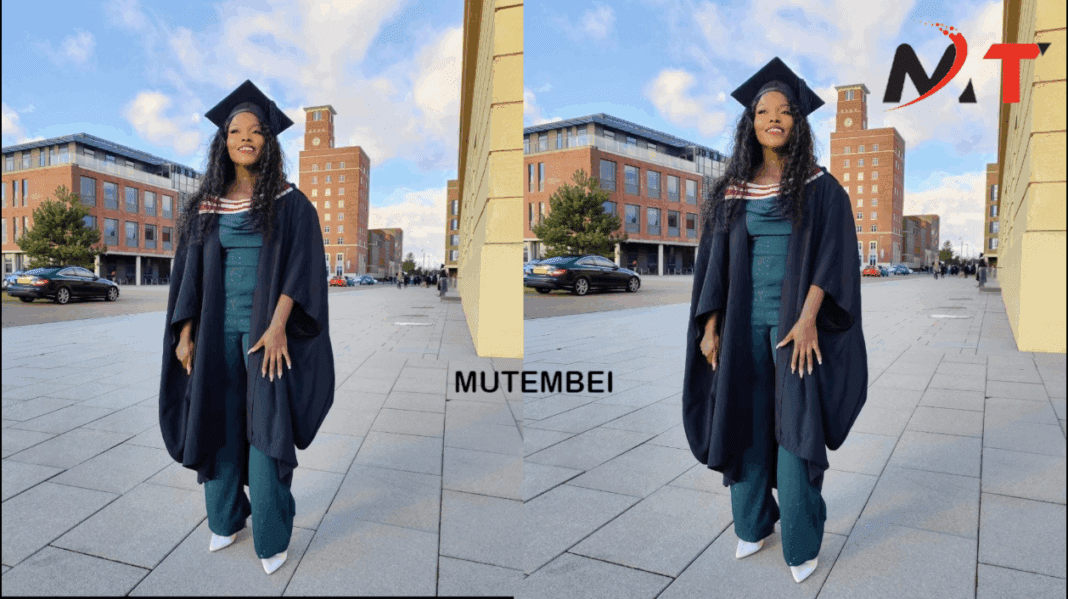From Kenyan Classroom to UK Cultural Spaces: A Career Path That Didn’t Exist
How one educator traded stability for possibility – and built something entirely new
EDITOR’S NOTE:This profile emerged organically from conversations with a Kenyan professional whose work in Wales caught my attention. After witnessing her unconventional career trajectory and community impact over the past year, I asked Sharon Chepchirchir if she’d be willing to share her journey. What follows is based on a Q&A session where she spoke candidly about creating a career category that didn’t exist before she invented it. To protect the privacy of the communities she serves – many of whom are refugees and asylum seekers who’ve requested their images not be shared publicly – this piece includes no identifying photos. Her story stands on its own.
The Path Nobody Chose
When she left her teaching position in Kericho County in 2020, friends and family had one word for her: crazy
“You have a stable job. You’re educated. Why risk it all?”
But she wasn’t interested in stability. She was interested in impact.
Three years later, UK organizations are calling her work “exceptional promise.” International nonprofits are hiring her to lead their digital transformations. And diaspora communities are seeking out her workshops.
This isn’t your typical “Kenyan nurse in America” or “Kenyan engineer in UK” story.
This is something different entirely.
The Education That Planted Seeds
Kabarak University, Baringo County.That’s where the journey began, studying Bachelor of Education Arts. But even then, traditional teaching felt incomplete.
“I loved teaching,” she reflects during our conversation. “But I kept asking: what if education could look different? What if learning wasn’t just about classrooms?”
From 2018 to 2020, she taught in two secondary schools in Kericho County. Good schools. Good students. Good work.
But “good” wasn’t the dream.
The Leap to Wales
2022:The move. Swansea University in Wales. Masters in Communication, Media Practice and Public Relations.
Her family’s reaction? Mixed.
“Some people were supportive. Others thought I was throwing away a good career for… what exactly?”
What exactly, indeed.
Because she wasn’t following a blueprint. She was about to create one.
The Career That Didn’t Have A Name
Here’s where the story gets interesting.
She didn’t arrive in Wales and slot into an existing job category. There was no posting for “Cultural Empowerment Practitioner” or “Community Heritage Interpreter.”
So she made one up.
Project 1: Giving Refugees Their Visual Voice
Photography 101: Snap & Edit – the workshop that changed everything.
Partnering with the Congolese Development Project in Wales, she taught asylum seekers and refugees something radical: how to document their own stories.
“Everyone was photographing them,” she explains when I ask about the workshop’s genesis. “Charity photos. News photos. Always being subjects. Never being storytellers.”
She taught them camera fundamentals. Composition. Lighting. Editing. But more than that – she taught them agency.
Participants who had never held a camera before learned to frame their own narratives. To choose what mattered in their visual stories. To move from being photographed to being photographers.
“One participant told me: ‘I can tell my story now. Nobody has to speak for me anymore,'” she recalls. “That’s when I knew this work mattered.”
That’s what cultural work looks like.
Project 2: Making History Belong to Everyone
*Revealing Swansea and Surrounding Areas: Industrial Heritage”- a project about belonging.
The Congolese Development Project wanted to help their community connect with Welsh history. But how do you make 19th-century copper foundries relevant to displaced Africans?
Her answer: bilingual heritage interpretation.
She designed an exhibition banner in both English and Welsh, featuring historical images from the West Glamorgan Archive Service. Swansea’s copper foundries. The old docks. The railway lines that built an industrial empire.
But she didn’t just present history. She made it a conversation.
“I told them: ‘This is YOUR history now too. You live here. You’re building lives here. This industrial past? It’s part of YOUR story now.'”
The banner was displayed at the library, and community members gathered around this piece of their new home’s past.
One participant captured it perfectly: “I never understood why Swansea looked the way it does. Now I know. And now I belong here a little more.”That’s what heritage interpretation creates.
Project 3: Making The Internet Accessible to Everyone
But she wasn’t done.
Women4Resources-an international nonprofit supporting women in extractive industries – needed help. Their website was difficult to navigate and impossible for people with disabilities to use.
She didn’t just redesign it. She transformed it.
WCAG compliance. Plain language. Semantic HTML. Alt-text on every image. Keyboard navigation. Color contrast that actually works.
“Accessibility isn’t about ticking boxes,” she tells me. “It’s about dignity. It’s about saying: ‘Your access matters. You matter.'”
The Co-Chair of Women4Resources wrote: “Her work isn’t just transformative – it’s a model for how digital spaces should serve people, not the other way around.”
The Recognition Nobody Expected
Three UK organizations have now endorsed her work:
Women4Resources: Called her work “transformative” and praised her “creative problem-solving” and “commitment to accessibility.”
Congolese Development Project: Highlighted her sustained partnership and community impact.
The Kenyan Diaspora Media:Named her an “emerging leader” showing “exceptional promise” in cultural media production.
The UK Director wrote: “She has achieved remarkable creativity in such a short time. She’s building something we didn’t know we needed.”
Not The Usual Diaspora Story
This is where her story diverges from the script.
Most Kenyan diaspora stories follow a pattern:
- Move abroad for specific career (nursing, engineering, tech, business)
- Work hard
- Succeed in that existing field
- Send money home
Hers is different:
- moved abroad without a clear “career slot”
- Created her own field
- Succeeding by building something that didn’t exist before
- Changing systems, not just navigating them
“I’m not smarter than nurses or engineers,” she’s quick to clarify when I raise this point. “But I asked a different question. Not ‘where can I fit?’ but ‘what needs to exist?'”
The Kenyan Advantage
Here’s her secret weapon: her Kenyan identity.
“UK heritage organizations struggle to engage diaspora communities. They ask me: ‘How do we make this relevant to refugees and immigrants?'”
“I tell them: ‘Let me show you. I’ve DONE what they’re doing. I’ve crossed worlds. I’ve navigated new cultures. I understand displacement. That’s not a disadvantage – that’s EXPERTISE.'”
Her transnational experience – growing up in Kenya, studying at Kabarak, teaching in Kericho, then pivoting to Wales – isn’t baggage. It’s her competitive advantage.
“When I design a heritage exhibition, I’m thinking: ‘What would have helped ME when I arrived in a new country? What makes you feel like you BELONG somewhere new?'”
“When I teach photography to asylum seekers, I’m remembering: ‘What does it feel like to have your story told BY other people instead of being able to tell it yourself?'”
“When I’m making websites accessible, I’m considering: ‘What if your first language isn’t English? What if you’re navigating technology after trauma? How do we serve ACTUAL people, not just ideal users?'”
Her Kenyan-ness isn’t incidental. It’s foundational.
The Career With No Blueprint
She’s frank about the challenges when I ask about sustainability:
“There’s no job posting for ‘Community Heritage Interpreter.’ No clear salary scale for ‘Participatory Arts Practitioner.’ I’m building this plane while flying it.”
She currently funds her work through consulting contracts, workshop facilitation fees, and project-based partnerships with nonprofits and cultural organizations.
“It’s a portfolio career,” she explains. “Part teaching, part design, part community organizing, part cultural translation. I don’t fit in a box. I AM the box.”
Her current work includes:
- Community arts education (photography workshops, visual storytelling training)
- Heritage interpretation (making museums and archives accessible to diverse audiences)
- Digital accessibility consulting (WCAG compliance, inclusive design)
- Volunteer coordination and training
- Cross-cultural partnership facilitation What’s Next?
Her vision is expanding:
Short-term:More photography workshops for diaspora communities across Wales. Partnerships with additional heritage organizations. Accessibility consulting for UK cultural institutions.
Long-term:”I want to prove this is a REAL career path. I want young Kenyans to see: ‘Oh, I can build a life in cultural work. I can use arts for social impact. That’s an actual option.'”
She’s also documenting her methodology: “If I can show other practitioners – in Kenya, in the UK, anywhere – how participatory heritage interpretation works, how to center community voice, how to make culture accessible… that multiplies the impact beyond just my projects.”
The Advice She’d Give Her Younger Self
When I ask what she wishes she’d known at the start, she pauses.
“Stop asking: ‘Where can I fit?’
Start asking: ‘What needs to exist?’
The world has enough people filling existing slots. It needs more people CREATING slots.
Also: Your Kenyan identity? Your non-traditional path? Your ‘weird’ combination of skills? That’s not a bug. That’s the FEATURE. That’s what makes you valuable.”
Why This Story Matters
In a sea of “Kenyan doctor in America” and “Kenyan tech entrepreneur in Canada” stories, this represents something different.
Proof that diaspora success doesn’t have to mean:
- Following existing career paths
- Maximizing salary
- Staying in your lane
It can mean:
- Creating new paths
- Maximizing impact
- BEING your own lane
From a classroom in Kericho to cultural spaces across Wales, this isn’t about climbing a ladder.
It’s about building your own and showing other Kenyans it’s possible.
The Journey So Far
2017-2021:Kabarak University, Baringo County – Bachelor of Education Arts
2018-2020:Secondary school teacher, Kericho County (two schools)
2022-2023:Swansea University, Wales – MA Communication, Media Practice & Public Relations
2023-Present:Community arts practitioner, heritage interpreter, digital accessibility specialist
Key Projects:
- “Photography 101: Snap & Edit” Workshop (Congolese Development Project)
- “Revealing Swansea: Industrial Heritage” Exhibition Design (CDP)
- Women4Resources Website Accessibility Transformation
- Ongoing community arts education initiatives
Recognition: - Women4Resources: “Transformative work”
- Kenya Diaspora Media: “Exceptional promise, emerging leader”
- Multiple UK organizational endorsements
This Kenyan community arts practitioner is based in Swansea, Wales, specializing in participatory visual storytelling, accessible heritage interpretation, and inclusive digital design. Her work centers on empowering marginalized communities to tell their own stories and making cultural spaces accessible to diverse audiences.
ABOUT THIS PIECE
As someone who’s watched this professional career unfold from a distance, I was struck by how different her path looked from typical diaspora narratives. When I reached out to ask if she’d share her story, she agreed on the condition that the focus remain on the work rather than personal publicity, and that the privacy of her community partners – many of whom are refugees who’ve experienced trauma – be protected. No photos of workshop participants or community members appear in this piece at their request. What remains is a story about possibility: what happens when you stop trying to fit into existing boxes and start building your own.



